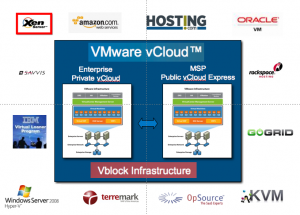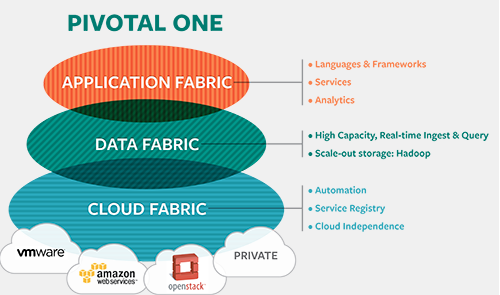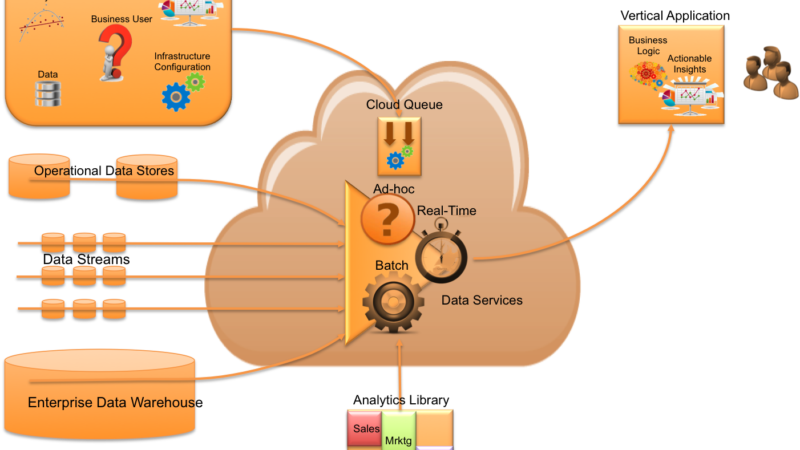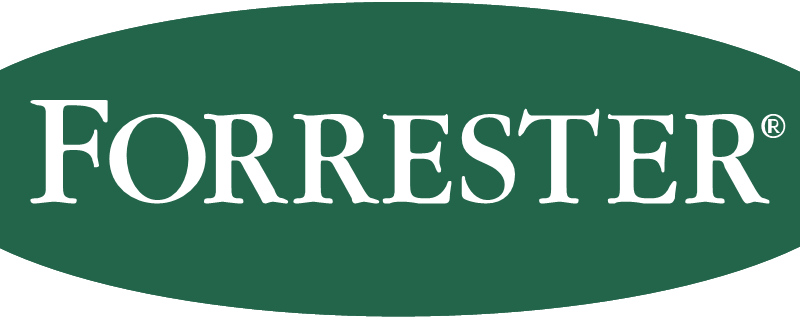VMware’s Largest Launch yet at VMWorld Next Week
Private and Public Cloud Comes Together
 Most people in the industry believe that Cloud Computing will have a major impact on what enterprises and their CIOs do in the future. That said, there are two important ways to view the Cloud:
Most people in the industry believe that Cloud Computing will have a major impact on what enterprises and their CIOs do in the future. That said, there are two important ways to view the Cloud:
1) as a computing architecture (I also refer to it as an “Enterprise Cloud Architecture”)…as a way to aggregate IT resources together to achieve much greater levels of efficiency and scalability and more flexible management; and
2) as a Service….whereby the enterprise utilizes IT resources that are provided by an external vendor. Both are very important aspects of the Cloud.
The Enterprise Cloud Architecture will be important in how internal IT is deployed, and every forward-thinking CIO and their organization needs to be thinking about how they will build their internal cloud that will allow them to utilize their resources more efficiently, and manage application workloads in a more flexible way. IT organizations will also be leveraging external clouds, and these two varieties of cloud will need to work together. The future of cloud will not be an “either or” (either internal or external), but more about managing a hybrid environment where IT can take advantage of both internal and external cloud with common infrastructure and common management.
It is interesting that the major advantages of having a cloud environment are the very things that VMware is struggling to provide to its customers:
1. flexible architecture for running applications, and
2. having a choice of running your applications either internally and/or externally.
Why do I say this? Because, the big question as we look at the offerings from the leader in the space is whether we really maximize “flexibility” and truly get the level of “choice” we need. I believe the ultimate level of flexibility and choice equates to an environment that is hardware agnostic (not just vBlocks), hypervisor agnostic (not just ESX), and internal or external cloud agnostic (not just vCloud and vCloud Express).
VMware believes they are going to begin to address this with their new offering to be announced next week called vCloud Service Director (code-named Redwood).
vCloud Service Director (code-named Redwood)
There’s been a lot of discussion on the street about VMware’s vCloud Service Director (vCSD). Details of VMware’s cloud computing product plans were revealed back in June, and will be formally announced next week at the Moscone Center, San Francisco during their VMWorld 2010 conference.
vCloud Service Director, codenamed Project Redwood, is a set of VMware technologies that provide the interface, automation, and management tools to tie VMware environments in the enterprise into private clouds and link them seamlessly with outside service providers running its vCloud Express service. The vCloud Express technology basically enables MSPs to offer Infrastructure as a Service (IaaS) based on VMWare. This directly competes with solutions from companies selling their own cloud “stack” to enable IaaS. Such players include: Openstack, Eucalyptus, OpenNebula, Enomaly, Nimbula, Cloud.com, Enstratus, Elastra, Kaavo, Abiquo, Appistry, Noliosoft…to name a few.
Creating a private cloud out of internal virtual infrastructure resources was a thing of the future until the above players began developing the “stacks” needed to provide “IaaS in a box”. Now the concept of connecting private clouds to public clouds for additional resources is somewhat theoretical.
The glue required to connect the resources together across internal and external infrastructures and manage them through a single pane of glass, is not simple. You look at leaders in public cloud management like RightScale and they will be the first to admit that moving the Amazon paradigm into other cloud environments is a far future (even then it will be a glue-job with connectors and converters that won’t be the most elegant solution).
VMware claims vCloud Service Director is the answer….at least for VMware users. Service providers say it can’t happen fast enough while enterprise IT shops have concerns over security and scalability, of course.

vCloud Service Director will provide enterprises with the following:
- Allow enterprises to create fully-functional internal cloud infrastructure
- Create a broad ecosystem of cloud providers to give enterprises choice in public cloud for burst, test/dev, etc.
- Provide identical interfaces between internal and external clouds to allow toolsets to operate identically with either
- Enable developers on the cloud platform to create new applications within a cloud framework across both private and public
I’m sure VMware, EMC and CISCO would love to see everyone follow the path of a completely packaged solution. If you want hear the details of this, make sure you attend the session MA8027 – Provisioning Cloud Computing on Vblock using VMware vCloud Service Director next week:
This session focuses on provisioning vApps in a cloud environment. Starting with at the hardware layer, provisioning of UCS servers in Vblock architecture, applying server profiles and related policies. Moving up the stack with installing and configuring vSphere, applying host profiles, creating and deploying network/storage policies. Carving out resource, network and storage pools for Cloud computing using VMware vCloud Service Director. Create Service catalogs, apply cost models using Chargeback, deploy vApps in multi-tenant environment.
vCloud Service Director will let users “serve themselves” by creating, using, and managing virtual machines and the application stack (e.g. vApps) while IT maintains control and bills for usage.
VMware’s aim is to build a control and management layer for a vSphere-based virtual infrastructure that controls outside services and internal resources seamlessly.
The VMware solution utilizes a catalog database and a service bus that governs all resource pools. The vCloud Service Director UI runs on VI Clients and works nicely with third party services giving IT and users access to libraries (images) published for accelerated development.
The hope is that VMware will interface other service providers not using ESX through the jclouds Java library that allows API access to public cloud providers and technologies. This, of course, does not promote VMware’s cause of VMwave-enabled MSPs. I’ll believe it when I see it.
Resource management with catalogs of virtual machine images and vApps provide the middle layer, with the vCloud API. The bottom of the vCloud stack comprises the hypervisor, hardware, etc. When the vCloud Service Director is fully implemented, VMware will be able to give users a true cloud computing environment without having to involve any other vendor. You ask me, if I was a CIO of a multi-national corporation this would scare me.
vCloud Service Director will allow multi-tenancy on top of vSphere, so users can create distinct virtual data centers (vDCs) out of one physical data center, or several virtual pools.
vCloud versus Open Source
Many think that you don’t get all the features you need from the open source clouds (aka OpenStack). It will be interesting to see how this changes with contributions like that of the Rackspace and OpenNebula teams. In talking to John Engates (CTO of Rackspace) and Joshua McKenty (Chief Cloud Architect for Nebula), I think some great things are happening in the world of open source. I believe the idea that open is behind is a fact of the past. Visionary CIOs who are challenging “VMware lockin” will quickly see past the deficiencies (which are shrinking) to see the benefits of a hardware, hypervisor, and management software agnostic environment.
vCloud High Availability / SLA
When you analyze the features of VMware HA, FT, and SDR, some business continuity experts are still crying “foul”. With the addition of App-aware HA using a monitoring API, VMware can leverage 3rd parties to monitor mission critical applications within the VM and notify VCenter and VMware HA to initiate a failover. This is great…however, it still does not address critical RPO and RTO requirements. It only provides a “pseudo application-aware HA” solution, improving slightly on the current VM-level HA.
VMware plans on talking about Host Based Replication (HBR) which will allow IT to replicate VM’s between dissimilar storage (However, it’s not clear that the product will be ready this year). With this, IT can replicate from an ESX local hard drive to a storage array in a different location. This technology, as a part of SRM, will allow IT to protect a remote location as if you had replicating storage arrays in common between it and your main datacenter.
SRM will also allow you to replicate individual VM’s as part of a protection strategy. This replication will be done without guest agents and is managed inside SRM.
Unfortunately, the application of host-based monitoring and failover (true application level HA) is still limited and the ability to manage HA/DR of mission critical applications across physical and virtual and heterogeneous virtualized environments is still impossible. VMware will have to make some significant announcements to truly provide a solution which addresses the market’s needs.
vCloud Security
For vCSD to really take off, VMware will have to announce it’s support for two or three-factor authentication for administrators, and the ability for secure VPN access for administrators.
What’s also missing is the ability to truly analyze SLA compliance and enforce it. We all know that the security group with IT organizations have the ultimate power. How does one finger-print VMs and not only lock down the stacks used within IT, but manage the where, who, when’s associated with VM sprawl from a security perspective?
vCloud Management across all private and public clouds
There is definitely value in merging familiar administrative tools and procedures across private and public clouds. But unless you are talking about merging vCenter, XenCenter, HyperV MMC, CA Spectrum Automation Manager, Tivoli Service Automation Manager, and a host of other management tool consoles, the “single pane of glass” does not become a reality.
Having to use different management tools for local physical, local virtual and cloud can be cumbersome. The current split between managing VMs and physical infrastructures already adds to administrative complexity. What an organization needs is a JSR168 compliant framework that allows IT to build their own Intranet portals based on the collection of tools already deployed.
vCloud resource management
vCloud Service Director will support three modes of resource management:
1. “Allocation pools,” where users are given a ‘container’ of resources and allowed to create and use VMs anyway they like up to the limits of the CPU and storage they paid for;
2. “Reservation pools,” which give users a set of resources they can increase or decrease by themselves and
3. “Pay-per-VM” for single-instance purchasing.
Ideally, this needs to evolve into a single IT resource catalog which combines VMware, Citrix, Microsoft, Amazon, etc. resources into a single web-based store for internal users.
Virtualization or Cloud Company?
VMware is a virtualization technology company trying to become a cloud computing technology company.
Will companies like Citrix, Microsoft, RedHat, and Oracle just sit on the sidelines and watch VMware turn the company towards IaaS, PaaS, and application services? Will the many fledgling venture-backed companies be able to leverage the power of open source to advance the cause of true interoperability, cross-platform, and non-proprietary?
Looking forward to seeing “VMware’s largest launch yet” next week 😉



